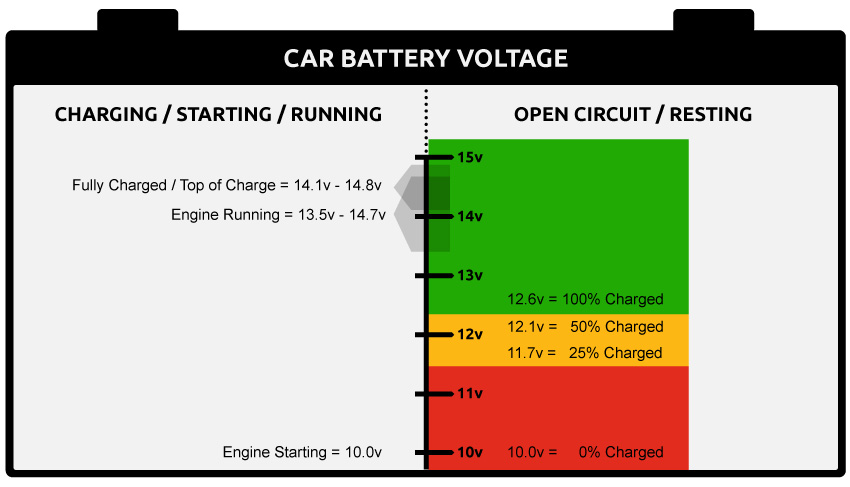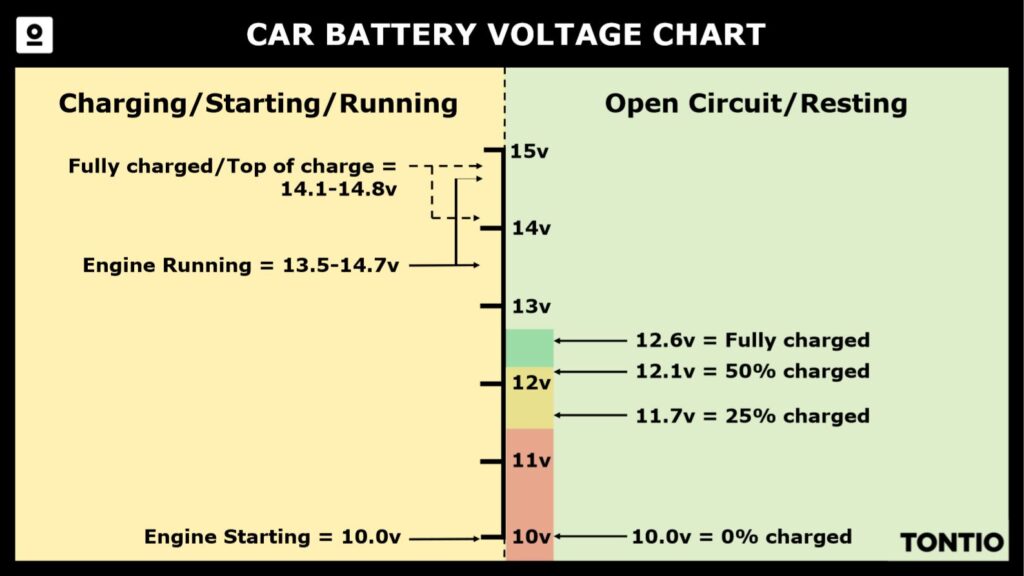A fully charged car battery typically has a voltage of about 12.6 volts. For a running engine, this voltage rises to around 13.7 to 14.7 volts.
Understanding the car battery voltage chart is crucial for maintaining your vehicle’s health and ensuring it runs smoothly. Car batteries are the silent workhorses of our vehicles, powering everything from the ignition to the lights. Knowing the optimal voltage range can help prevent breakdowns and extend the life of your battery.
This guide aims to demystify the numbers behind car battery voltages, making it easier for you to keep your car in top condition. Keep your vehicle’s performance at its peak by staying informed about the simple yet vital aspect of car maintenance: the battery voltage.

Credit: www.batteriesplus.com
The Significance Of Car Battery Voltage
Understanding the significance of car battery voltage is crucial. A car’s heart is its battery. A healthy battery ensures a smooth ride. But, a weak battery can cause trouble.
Indicators Of Battery Health
Several signs indicate a battery’s health. It’s vital to know these. They help prevent sudden failures.
- Voltage readings: A strong battery shows 12.6 volts or more. Below 12.4 volts means it’s weak.
- Slow engine crank: Taking longer to start? Your battery might be weak.
- Warning lights: A battery or check engine light can indicate problems.
- Swollen battery case: Shows the battery is failing. Replace it.
Impact On Vehicle Performance
A battery’s voltage impacts how your car runs. Let’s see how.
| Battery Voltage | Impact on Performance |
|---|---|
| 12.6V or Higher | Optimal performance. All systems go! |
| 12.0V – 12.5V | Acceptable but recharge soon. |
| Below 12.0V | Weak. May cause starting issues. |
Low voltage affects the car’s power. It can slow down window operation and dim headlights. In short, it makes your car sluggish.

Credit: www.reddit.com
Decoding The Car Battery Voltage Chart
Understanding your car’s battery voltage is crucial for maintaining optimal performance. A car battery voltage chart helps you know your battery’s health. Let’s decode this chart together.
Reading The Voltage Levels
Checking your car’s battery voltage is simple with a multimeter. To get accurate readings, turn off the engine and all electronics. Connect the multimeter to your battery’s positive and negative terminals. The display will show the voltage level.
Here’s a quick guide to reading voltage levels:
- 12.6V and above: Fully charged
- 12.4V to 12.6V: Partially charged
- 12.2V: 50% charged
- Below 12V: Low charge
What The Numbers Mean
Voltage numbers tell your battery’s charge state. Regular checks prevent breakdowns. A fully charged battery should read around 12.6 volts. Under 12 volts, your battery needs attention.
Interpreting voltage readings:
| Voltage Level | Charge Status |
|---|---|
| 12.6V+ | Fully Charged |
| 12.4V – 12.6V | Good |
| 12.2V | Half Charged |
| Below 12V | Needs Charging |
Remember: Battery care ensures a longer life. Use the voltage chart to keep your battery in check. Perform regular maintenance for the best results.
Standard Voltage Ranges For Car Batteries
Understanding the standard voltage ranges for car batteries is crucial for vehicle maintenance. A car battery’s voltage can indicate its health and charge level. Knowing these ranges helps diagnose issues and ensure reliable performance.
Healthy Voltage Range
A fully charged car battery should read at around 12.6 volts or above when the engine is off. This voltage ensures that your vehicle’s electrical system functions properly.
Voltage While Starting The Engine
When you start the engine, the battery voltage dips temporarily. A healthy battery will show a voltage of about 10 volts during the start before rising again.
When To Be Concerned
If the battery voltage falls below 12.4 volts when the engine is off, it’s a sign the battery needs attention. Voltages under 12 volts are a red flag, and the battery may require charging or replacement.
Keep an eye on your battery’s voltage with these benchmarks:
| Condition | Voltage Range |
|---|---|
| Engine Off (Fully Charged) | 12.6 to 12.8 volts |
| Engine Starting (Healthy Battery) | ~10 volts |
| Engine Off (Low Charge) | 12.0 to 12.4 volts |
| Engine Off (Discharged) | Below 12 volts |
- Regularly check your car battery voltage.
- Use a multimeter for accurate readings.
- Charge your battery if voltages are low.
Maintain your car’s battery and stay ahead of potential issues with these guidelines.
Testing Your Car Battery Voltage
Testing your car battery voltage is crucial for maintaining its health. This process helps you understand if your battery needs a charge or replacement. Let’s dive into the tools you need and a step-by-step guide for measuring your car battery’s voltage.
Tools Needed For Voltage Testing
- Voltmeter: A device to measure voltage.
- Safety gloves: To protect your hands.
- Eye protection: To keep your eyes safe.
Step-by-step Guide To Measuring Voltage
- Ensure safety. Wear gloves and eye protection.
- Turn off the car. Make sure all lights and the radio are off too.
- Open the car’s hood to find the battery.
- Identify the positive and negative terminals on the battery. They are usually marked with + and – signs.
- Set your voltmeter to the DC voltage setting. This setting looks like a V with a straight line.
- Connect the voltmeter’s red lead to the battery’s positive terminal.
- Connect the black lead to the negative terminal.
- Read the voltage on the voltmeter. A healthy car battery should show 12.6 volts or above.
- If the voltage is below 12.4 volts, your battery needs charging.
- If it’s below 12 volts, it’s likely your battery needs replacement.
Regularly testing your car battery voltage ensures it’s always ready to power your journeys. Remember, keeping your battery healthy extends its life and saves money in the long run.
Interpreting Voltage Test Results
Interpreting Voltage Test Results is crucial for maintaining a healthy car battery. A voltage test can tell you if the battery is in good condition or needs attention. Understanding these results ensures your vehicle remains reliable. Let’s decode what the numbers mean.
Understanding High Voltage Readings
A high voltage reading on your car battery can be puzzling. It often indicates overcharging. Overcharging can harm battery life. Here’s what to look for:
- Normal Voltage Range: 12.6 to 12.8 volts when the car is off.
- High Voltage: Above 12.9 volts can signal a problem.
To address high voltage, inspect the vehicle’s charging system. A mechanic can check for issues. Regular checks prevent damage to the battery.
Dealing With Low Voltage Readings
Low voltage readings can cause car trouble. They mean the battery is undercharged or failing. Signs include:
- Healthy Battery: Should read 12.4 to 12.8 volts.
- Low Voltage: Below 12.4 volts needs action.
If your battery shows low voltage, charge it. If it doesn’t hold a charge, it may need replacing. Have a professional test the battery to be sure.
Note: Always perform voltage tests with the engine off. Use a reliable multimeter for accurate readings.
Maintenance Tips To Optimize Battery Voltage
Keeping your car’s battery in top condition is crucial. A well-maintained battery ensures your vehicle starts reliably and powers all its electrical components. Let’s dive into some essential tips to keep that voltage optimal.
Regular Battery Checkups
Consistent battery inspections prevent unexpected failures. These checks can pinpoint issues early. They save you from being stranded with a dead battery.
- Measure voltage monthly to track battery health.
- Look for corrosion on terminals. Clean if needed.
- Ensure connections are tight and secure.
Best Practices For Battery Longevity
Extend your battery’s life with these best practices. Good habits lead to lasting performance.
- Turn off lights and electronics when the engine’s off. This prevents unnecessary drain.
- Limit short trips. Short trips don’t allow the battery to fully charge.
- Keep the battery tightly fastened. This stops damage from vibrations.
Seasonal changes affect battery performance. Keep it warm in winter and cool in summer. Use insulation covers and park in the shade.
| Season | Care Tip |
|---|---|
| Winter | Use insulation covers to keep the battery warm. |
| Summer | Park in the shade to prevent overheating. |
Troubleshooting Common Battery Voltage Issues
Car battery problems can leave you stranded. Understanding a car battery voltage chart is key. It helps diagnose issues quickly. Let’s troubleshoot common battery voltage problems and get your vehicle back on the road.
Addressing Voltage Fluctuations
Voltage fluctuations in car batteries can be puzzling. They often hint at underlying issues. Regular checks are vital. A healthy car battery should show 12.6 volts or above when the engine is off. Less indicates a charge problem.
- Check connections: Tighten loose terminals.
- Inspect for corrosion: Clean any white or green buildup.
- Test alternator: An alternator maintains voltage. Get it checked.
- Use a voltmeter: Confirm your battery’s health at various states.
Remember, extreme temperatures affect battery performance. Keep your vehicle in a garage during harsh weather.
Solutions For Persistent Voltage Problems
When voltage issues persist, it’s time to dig deeper. A failing battery won’t hold a charge well. It often needs replacing. Let’s explore solutions:
- Charge your battery: Use a charger overnight. Recheck voltage.
- Load test: This test reveals the battery’s ability to maintain voltage under load. A mechanic can perform this.
- Check the electrical system: Faulty components drain the battery. Have a professional inspect the system.
- Replace if necessary: Batteries have a life span. If yours is old, consider a replacement.
| State of Charge | Voltage (12V Battery) |
|---|---|
| Fully Charged | 12.6 to 12.8V |
| 75% Charged | 12.4V |
| 50% Charged | 12.2V |
| 25% Charged | 12.0V |
| Discharged | < 11.9V |
Use the chart above to gauge your battery’s state. If your battery often falls below the ‘Fully Charged’ range, it’s a red flag. Address it promptly to prevent getting stuck with a dead battery.

Credit: www.pinterest.com
Frequently Asked Questions
What Is The Normal Voltage For A Car Battery?
The normal voltage for a fully charged car battery is about 12. 6 volts.
What Is A Bad Voltage For A Car Battery?
A bad voltage for a car battery is below 12. 2 volts. This indicates it’s less than 50% charged. Voltages under 12 volts mean the battery is significantly discharged and needs immediate attention. Regular checks ensure optimal performance and longevity of your car battery.
At What Voltage Should A Car Battery Be Replaced?
A car battery should be replaced if its voltage drops below 12. 4 volts while the engine is off. Regular testing ensures optimal performance.
At What Voltage Is A Car Battery Dead?
A car battery is considered dead if it measures below 12. 0 volts. Regular voltage for a fully charged battery is about 12. 6 volts.
Conclusion
Understanding car battery voltage levels is crucial for vehicle maintenance. This chart simplifies monitoring your battery’s health. Regular checks ensure longevity and prevent breakdowns. Bookmark this guide for quick reference and drive with confidence, knowing you’re powered by the right voltage.
Keep your journey smooth and your car reliable with this essential knowledge.
